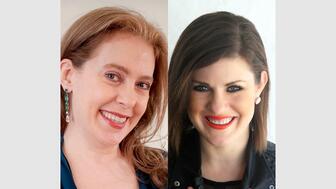Price, Color and Supply Trends: A Colored Stone Market Update
Kimberly Collins, Adrianne Sanogo, Monica Stephenson and Jaimeen Shah shared their insights during an education session at JCK Las Vegas.

JCK magazine Editor-in-Chief Victoria Gomelsky moderated the discussion.
The panelists were: Kimberly Collins, CEO/founder of Kimberly Collins Colored Gems and president of the American Gem Trade Association board of directors; Adrianne Sanogo, GIA Graduate Gemologist, Graduate Pearl diploma holder and co-founding board member and education chair of the Black in Jewelry Coalition; Monica Stephenson, founder of Anza Gems and founding collaborator of Moyo Gems, an initiative bringing gems from women artisanal miners in Tanzania and Kenya to market; and Jaimeen Shah, partner at rough-to-polish gemstone supply house Prima Gems USA with more than 20 years’ experience in the gemstone industry.
Here are the major points from their conversation on the current state of the colored stone market.
Overall, the mood around colored gems is optimistic, with many mentions about good turnout at the shows this year.
Collins, speaking about AGTA GemFair Tucson earlier this year, said, “People were out in droves buying color.”
Greens and pinks are standing out.
“The mints—the Merelani mints, the mint tourmaline, the tsavorites—hot, hot, hot colors,” Collins said.
Collins also noted a correlation in color sales with the Pantone “Color of the Year” for 2023, Viva Magenta, and ultimately an uptick in interest in color across the spectrum.
“Whereas we’ve been selling a lot of peachy pinks and pastels, the pinks are getting hotter. I’ve seen that again in this show,” Collins said. “Some years I sell only a certain color; it kind of has that flow. This year, it was across the board.”
When it comes to fall and holiday trends, Collins, Stephenson and Shah are betting on pink colored gemstones, like Viva Magenta and Malaya (Malaia) garnets.
Sanogo is expecting an increase in interest in verdant stones, namely the Madagascan Demantoid.
As for pink gemstones, Sanogo recounted a conversation with GIA about a new heat treatment for pink sapphires that retailers should be aware of.
“There is a destabilizing technique [GIA] uses, and if [the sapphire’s color] survives that technique, it is a Padparadscha,” she said. “If it loses its color, then you know it’s just a regular pink sapphire, which are also beautiful but the price point is different.”
Sanogo also touched on trends to come, what she believes are the “sleeper gems” — spinel, garnet and tourmaline, all of which come in a multitude of colors and a wide range of price points.
She said, “I have noticed green gems are becoming very popular; people are looking at green gems across the entire gem family. You can get beautiful greens in tourmaline and you can get them in garnet.”
She brought up the topic of treatment a second time, namely for spinel. Earlier this year, GIA published an article on nickel-diffused spinel, a treatment its researchers had not seen before.
“If you’re seeing a spinel in a color you don’t see often, you might want to send it to a laboratory to get all the details on it because there are a lot of treatments out there, good treatments, but they’re not always disclosed, which is what we’re supposed to be doing,” she said.
“Even if it’s a low price point, I think a gem report is always a valuable tool.”
The panelists’ companies report good business even in light of higher prices.
“All my higher-end stuff has seemed to pop,” Collins said. “It just seems the retailer is looking for things to diversify themselves from the store down the street. They’re looking for a lot more one-of-a-kind, a lot more color that can set them apart from their competitors.”
Retailers that came by her booth were struck by the prices, but in the end said, “I can still sell it.”
Shah echoed Collins’ sentiment, saying, “Color in general is a trend … but high-end color is absolutely the right way to go right now because you have so much more to offer.”
The higher prices are seen across a variety of colored gems.
“Rubies and emeralds for me, that’s like 20 to 30 percent higher,” Collins said, noting the current sanctions on Burma, a sought-after supplier of rubies.
“We’re looking at Mozambique for all of our ruby sources and anything that’s out there from Burma is recycled in the industry.”
For emeralds, she has seen prices rising for Colombian goods, but a bit less for Zambian goods.
“The Panjshir Valley, the Afghani emeralds, it’s questionable whether we should be selling it,” she said. “We don’t have sanctions on Afghanistan, but we need to make sure we’re sourcing ethically and we’re not funding the Taliban.”
Sanogo saw an uptick in prices for green sapphires, which she said used to be more inexpensive.
“The other thing is melee; color gem melee is being used because diamonds were hard to get in melee sizes.”
Stephenson pointed out that it isn’t just dealers raising prices; material scarcity is driving some of the increases too.
“They’re hearing from people in East Africa,” she said. “The rough is really, really difficult to find.”
Shah recounted a conversation he had with employees at one major colored gemstone wholesaler, Intercolor USA.
“From the Bangkok show to Vegas, in a four-month cycle, they’ve seen an increase of 60 percent in sapphire prices,” he said. “It’s amazing to see it’s not just the rubies and the sapphires that are in trend, but the alternatives, the pinks, the purples, the greens,” he said.
He also noticed retailers appear less afraid to work with color due to lack of education.
Shah often reminds retailers that with a colored gemstone, they are receiving a story behind the gem that is, “hard to find in a piece of diamond jewelry or a piece of lab-grown jewelry.”
The industry is in a sustainable place in terms of pandemic disruption recovery.
Colored stones come from all over the world and, as Stephenson noted, “Gems come from people, not just the ground or Tucson.”
“About 80 percent of colored gemstones come from small-scale and artisanal mines,” she said. “So not the big, large-scale open-pit mines like diamonds.”
Stephenson said she will be attending the August trip hosted by Gem Legacy Adventures to visit artisanal mines in Africa. The nonprofit is also hosting a trip in January of next year.
https://nationaljeweler.com/articles/11889-gem-legacy-adventures-announces-2024-dates-for-east-africa-trip
Overseas suppliers are vital to the industry and Shah said disruptions overseas can have a big impact on the supply chain as a whole, such as COVID regulations restricting miners travel from one town to another to drop off goods.
He believes the industry has moved beyond the upset by way of its biggest strength—adaptation.
“We’ve come out stronger because there are factories that say, ‘here’s my main factory but here are extra factories I have in case of things happening again in the future.’ Similarly, when we attend a show, we are signing off on insurances saying if the show is canceled, none of us are financially indebted,” Shah said.
“We are coming back smarter, and hopefully it [a pandemic] never happens again, but we will be way better prepared for any sort of disruption in the future, and that’s the important thing here.”
The Latest

The luxury goods company said founder Ippolita Rostagno will remain at the brand’s helm.

Laura Burdese, who joined the Italian luxury brand in 2022, will take on the role in July.

The National Jeweler editors revisit the most noteworthy industry happenings and design trends from 2025.

How Jewelers of America’s 20 Under 40 are leading to ensure a brighter future for the jewelry industry.

Need a gift for the cat lover who has everything? Look no further than our latest Piece of the Week.


It purchased the “Grosse Pièce,” an ultra-complicated Audemars Piguet pocket watch from the ‘20s, for a record-breaking price at Sotheby’s.

The lab-grown diamond grower now offers custom engagement and fashion jewelry through its Kira Custom Lab Jewelry service.

Roseco’s 704-page catalog showcases new lab-grown diamonds, findings, tools & more—available in print or interactive digital editions.

Chandler got his start at Michelson Jewelers and has served as DCA president and CEO since 2001. He will retire at the end of the month.

The boutique is slated to open this week inside Terminal 8, offering pre-owned Rolex watches and more to international travelers.

Sponsored by Digital Monitoring Products

The special-edition egg pendant ingested in a New Zealand jewelry store was recovered after a six-day wait.

Associate Editor Natalie Francisco plays favorites with Piece of the Week, selecting a standout piece of jewelry from each month of 2025.

The “Love and Desire” campaign is inspired by the magic that follows when one’s heart leads the way, said the brand.

Two awardees will receive free tuition for an educational course at the Swiss lab, with flights and lodging included.

Berta de Pablos-Barbier will replace Alexander Lacik at the start of January, two months earlier than expected.

Sotheby’s held its first two jewelry sales at the Breuer building last week, and they totaled nearly $44 million.

Winners will receive free registration and lodging for its fourth annual event in Detroit.

Here are six ideas for making more engaging content for Instagram Reels and TikTok, courtesy of Duvall O’Steen and Jen Cullen Williams.

The honorees include a notable jewelry brand, an industry veteran, and an independent retailer.

Carlos Jose Hernandez and Joshua Zuazo were sentenced to life without the possibility of parole in the 2024 murder of Hussein “Sam” Murray.

Yood will serve alongside Eduard Stefanescu, the sustainability manager for C.Hafner, a precious metals refiner in Germany.

The New Orleans jeweler is also hosting pop-up jewelry boutiques in New York City and Dallas.

Set in a Tiffany & Co. necklace, it sold for $4.2 million, the highest price and price per carat paid for a Paraíba tourmaline at auction.

The jeweler’s “Deep Freeze” display showcases its iconic jewelry designs frozen in a vintage icebox.

Take luxury gifting to new heights this holiday season with the jeweler’s showstopping 12-carat sphene ring.

This year's theme is “Unveiling the Depths of the Ocean.”































